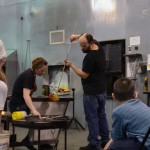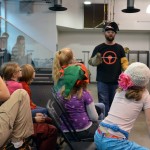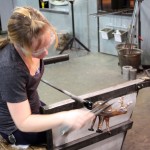With winter comes one of my all-time favorite programs: 3rd Grade You Design it; We Make it. This program integrates the science curriculum third graders are learning in school with experiences at the Museum. The Museum invites all the 3rd grade classes in the Corning/Painted Post school district to participate.
While here, our young visitors tour the Frederick Carder Gallery and Rakow Research Library. Here students learn about Frederick Carder, one of America’s most successful and influential glass designers. At the Library, they discover why the glass industry moved to Corning and why it thrived here. They look at Carder’s glass designs in the gallery and use primary materials in the Library to gain a better understanding of the area’s history.
They also are invited to a special glassblowing demonstration.
For us at The Studio, it all begins with a couple dozen 8 and 9 year olds bouncing in and taking a seat on folding chairs set out on the hot shop floor. After introductions and a safety talk, we dive right into their science curriculum, beginning with measurements. Before the visit, each student created a design drawing that they would like to have executed in glass, complete with dimensions. The gaffer picks the drawing that will be the most exciting to watch and can be completed in the hour we have with the students. We discuss tools of measurement for glassmakers. The first tool introduced is the calipers, an adjustable device used to measure the distance between two opposite sides of an object. We explain how we use this tool to make the students design “approximately” the size they indicated on their drawing.
We then jump into temperatures. How would you measure the temperature of hot cocoa? Hands fly up. Bodies bop up and down. A thermometer they cry. Could you stick a thermometer into molten glass? A resounding NOOOOO comes from the audience.
We then break out our ultra-cool looking infrared thermometer. Shaped like a red space gun from the same era as mammoth cellular telephones, our infrared thermometer can measure the temperature of something over 1000 degrees Fahrenheit just by pointing the gun at the object and pulling the trigger. We establish temperatures for several points in the glass’s working range, matching the temperature with the color of the glass and the amount of movement. We talk about the temperature in relation to the color of glass and movement. Glass “glows” when it is hot and moving. As it cools it loses that glow and becomes stiffer and stiffer until it stops moving completely.
After this introduction to the material we ask for a ………… Drum Roll Please! ………… And we announce the drawing that will be made that day. Interestingly, the student who created the drawing that is chosen is often sitting right up front. During the creation of the design we talk about their assigned vocabulary words—blowpipe, bench, gaffer, shears, and furnace.
- 3rd Grade You Design it; We Make it at The Studio
- Making a deer for the 3rd graders’ You Design it; We Make it program
We also discuss team work and the relationship between a designer and a gaffer. Does anyone here play team sports? Hands shoot up. Would it be as much fun to play basketball, baseball or volleyball without a team? Another resounding NO! We explain that glassblowing is like a team sport. Some people do work alone but we think it is much easier and more fun to work together.
We also take questions, Is it hot? Do you get burned? are among the favorites. As is What is the best, coolest, biggest thing you have ever made? And the ever popular How old are you?
For an hour we have 100% of their attention and it’s rewarding to be able to tie what they learn in science class to the magic they see right in front of them. Once complete, the glass design stays overnight to be annealed and then is available for the school. Every school is a little different, but most display the piece for a period of time before sending it home with the student designer.
Everyone learns in different ways and it is rewarding to help children learn their curriculum in a less traditional classroom setting. I hope our third grader visitors leave knowing that our Museum isn’t a stuffy boring place but somewhere exciting to travel to, somewhere fun to be and somewhere you can learn something new or apply knowledge that you already have.








5 comments » Write a comment